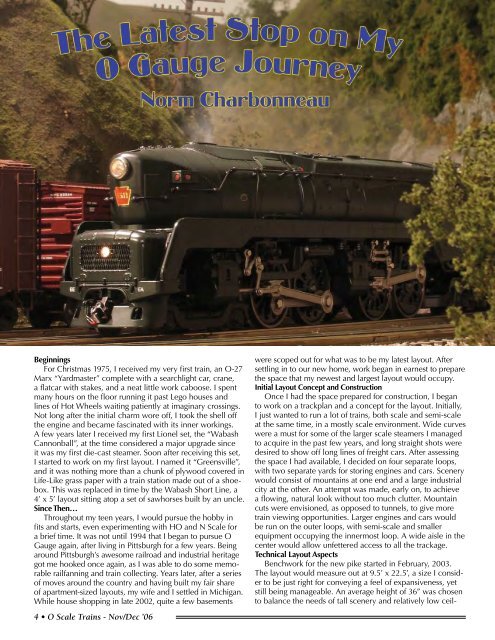O Scale Trains Magazine Online
O Scale Trains Magazine Online
O Scale Trains Magazine Online
- TAGS
- trains
- oscalemag.com
You also want an ePaper? Increase the reach of your titles
YUMPU automatically turns print PDFs into web optimized ePapers that Google loves.
eginnings<br />
For Christmas 1975, I received my very first train, an O-27<br />
Marx “Yardmaster” complete with a searchlight car, crane,<br />
a flatcar with stakes, and a neat little work caboose. I spent<br />
many hours on the floor running it past Lego houses and<br />
lines of Hot Wheels waiting patiently at imaginary crossings.<br />
Not long after the initial charm wore off, I took the shell off<br />
the engine and became fascinated with its inner workings.<br />
A few years later I received my first Lionel set, the “Wabash<br />
Cannonball”, at the time considered a major upgrade since<br />
it was my first die-cast steamer. Soon after receiving this set,<br />
I started to work on my first layout. I named it “Greensville”,<br />
and it was nothing more than a chunk of plywood covered in<br />
Life-Like grass paper with a train station made out of a shoebox.<br />
This was replaced in time by the Wabash Short Line, a<br />
4’ x 5’ layout sitting atop a set of sawhorses built by an uncle.<br />
since then…<br />
Throughout my teen years, I would pursue the hobby in<br />
fits and starts, even experimenting with HO and N <strong>Scale</strong> for<br />
a brief time. It was not until 1994 that I began to pursue O<br />
Gauge again, after living in Pittsburgh for a few years. Being<br />
around Pittsburgh’s awesome railroad and industrial heritage<br />
got me hooked once again, as I was able to do some memorable<br />
railfanning and train collecting. Years later, after a series<br />
of moves around the country and having built my fair share<br />
of apartment-sized layouts, my wife and I settled in Michigan.<br />
While house shopping in late 2002, quite a few basements<br />
• O <strong>Scale</strong> <strong>Trains</strong> - Nov/Dec ’06<br />
were scoped out for what was to be my latest layout. After<br />
settling in to our new home, work began in earnest to prepare<br />
the space that my newest and largest layout would occupy.<br />
initial Layout Concept and Construction<br />
Once I had the space prepared for construction, I began<br />
to work on a trackplan and a concept for the layout. Initially,<br />
I just wanted to run a lot of trains, both scale and semi-scale<br />
at the same time, in a mostly scale environment. Wide curves<br />
were a must for some of the larger scale steamers I managed<br />
to acquire in the past few years, and long straight shots were<br />
desired to show off long lines of freight cars. After assessing<br />
the space I had available, I decided on four separate loops,<br />
with two separate yards for storing engines and cars. Scenery<br />
would consist of mountains at one end and a large industrial<br />
city at the other. An attempt was made, early on, to achieve<br />
a flowing, natural look without too much clutter. Mountain<br />
cuts were envisioned, as opposed to tunnels, to give more<br />
train viewing opportunities. Larger engines and cars would<br />
be run on the outer loops, with semi-scale and smaller<br />
equipment occupying the innermost loop. A wide aisle in the<br />
center would allow unfettered access to all the trackage.<br />
technical Layout Aspects<br />
Benchwork for the new pike started in February, 2003.<br />
The layout would measure out at 9.5’ x 22.5’, a size I consider<br />
to be just right for conveying a feel of expansiveness, yet<br />
still being manageable. An average height of 36” was chosen<br />
to balance the needs of tall scenery and relatively low ceil-

















